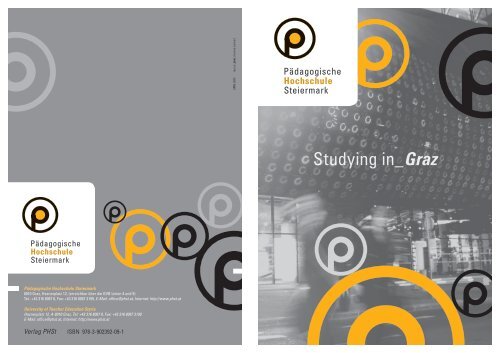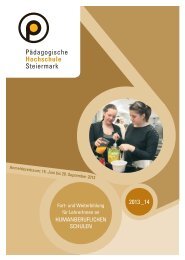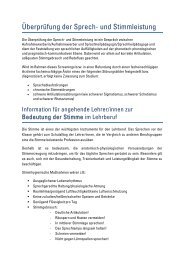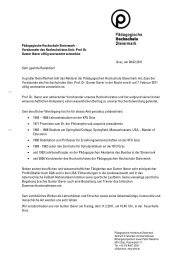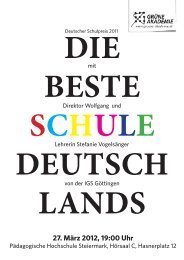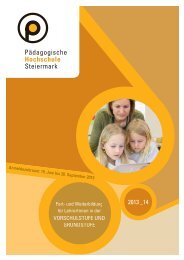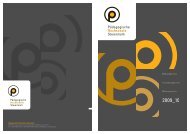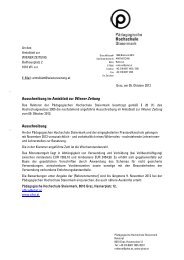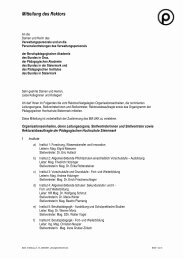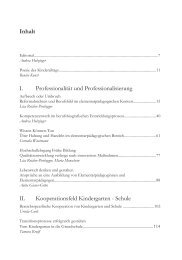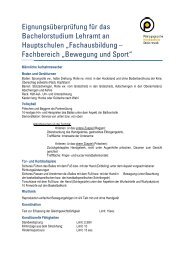courses _offered - Pädagogische Hochschule Steiermark
courses _offered - Pädagogische Hochschule Steiermark
courses _offered - Pädagogische Hochschule Steiermark
Erfolgreiche ePaper selbst erstellen
Machen Sie aus Ihren PDF Publikationen ein blätterbares Flipbook mit unserer einzigartigen Google optimierten e-Paper Software.
<strong>Pädagogische</strong> <strong>Hochschule</strong> <strong>Steiermark</strong><br />
8010 Graz, Hasnerplatz 12, (erreichbar über die GVB Linien 4 und 5)<br />
Tel.: +43 316 8067 0, Fax: +43 316 8067 3199, E-Mail: office@phst.at, Internet: http://www.phst.at<br />
University of Teacher Education Styria<br />
Hasnerplatz 12, A-8010 Graz, Tel: +43 316 8067 0, Fax: +43 316 8067 3199<br />
E-Mail: office@phst.at, Internet: http://www.phst.at<br />
Verlag PHSt ISBN 978-3-902392-09-1<br />
2010_0930 layout: phst_thomas markart<br />
Studying in_Graz
Studieren in_Graz<br />
Internationaler Studienführer<br />
3
Impressum:<br />
Verlag PHSt<br />
<strong>Pädagogische</strong> <strong>Hochschule</strong> <strong>Steiermark</strong><br />
Mag. Susanne Linhofer, Elfriede Koller,<br />
Elfriede Losinschek, Heiko Vogl (Red.): Studying in Graz<br />
Layout: Thomas Markart<br />
Fotos: PHSt-Archiv<br />
Sissi Furgler Fotografie/S.5<br />
Graz Tourismus/S.8-11<br />
Druck: Dorrong, Graz<br />
Graz © 2008, Nachdruck 2010<br />
ISBN 978-3-902392-09-1<br />
Gefördert aus Mitteln der Europäischen Union<br />
<strong>Pädagogische</strong> <strong>Hochschule</strong> <strong>Steiermark</strong><br />
8010 Graz<br />
Hasnerplatz 12<br />
Tel.: +43 316 8067 0<br />
Fax: +43 316 8067 3199<br />
E-Mail: office@phst.at<br />
Internet: http://www.phst.at<br />
Willkommen in Graz!<br />
Willkommen an der<br />
<strong>Pädagogische</strong>n <strong>Hochschule</strong> <strong>Steiermark</strong>!<br />
Wir freuen uns, dass Sie die <strong>Pädagogische</strong> <strong>Hochschule</strong><br />
<strong>Steiermark</strong> für Ihr Auslandsstudium gewählt haben.<br />
Die persönliche Betreuung der Gaststudierenden, Freundlichkeit<br />
und Hilfestellung ist uns allen ein besonderes Anliegen.<br />
Aus diesem Grund dürfen wir Ihnen diese Broschüre überreichen.<br />
Sie enthält wichtige Informationen und soll Sie als hilfreicher<br />
Leitfaden während des Studiums in Graz begleiten.<br />
Wir wünschen Ihnen viel Freude und Erfolg für Ihr Studium an<br />
der <strong>Pädagogische</strong>n <strong>Hochschule</strong> <strong>Steiermark</strong> und hoffen, dass<br />
Sie sich vom ersten Tag an in unserem Hause wohlfühlen.<br />
Mag. Dr. Herbert Harb, Rektor<br />
Welcome to Graz!<br />
Welcome to the<br />
University of Teacher Education Styria!<br />
We are very glad you have chosen the University of Teacher<br />
Education Styria for your study abroad experience and therefore<br />
we would like to offer you the assistance of this International Student<br />
Directory. In this directory you will find important course information<br />
as well as practical information regarding your stay in Graz.<br />
Our primary mission is to assist international students in successfully<br />
accomplishing the goals that brought them to our campus and<br />
therefore please do not hesitate to contact us.<br />
We wish you all the best during your studies here at the<br />
University of Teacher Education Styria, and we hope that you<br />
will feel at home from the first day.<br />
Dr. Herbert Harb, Rector<br />
4 5<br />
welcome_to graz
important<br />
Wichtige Adressen<br />
<strong>Pädagogische</strong> <strong>Hochschule</strong> <strong>Steiermark</strong><br />
A-8010 Graz, Hasnerplatz 12<br />
Tel.: +43 316 8067 0, Fax: +43 316 8067 3199<br />
E-Mail: office@phst.at<br />
Internet: http://www.phst.at<br />
Rektor<br />
Mag. Dr. Herbert Harb<br />
Tel.: +43 316 8067 0<br />
E-Mail: rektorat@phst.at<br />
Vizerektorin<br />
der <strong>Pädagogische</strong>n <strong>Hochschule</strong> <strong>Steiermark</strong> (Ausbildung)<br />
Mag. a Dr. in Regina Weitlaner<br />
Tel.: +43 316 8067 0<br />
E-Mail: rektorat@phst.at<br />
Vizerektorin<br />
der <strong>Pädagogische</strong>n <strong>Hochschule</strong> <strong>Steiermark</strong> (Weiterbildung)<br />
Mag. a Renate Gmoser<br />
Tel.: +43 316 8067 0<br />
E-Mail: rektorat@phst.at<br />
Institut 2 - Allgemeinbildende Pflichtschulen<br />
einschließlich Vorschulstufe - Ausbildung<br />
Institutsleiterin: Mag. a Dr. in Erika Rottensteiner<br />
Tel.: +43 316 8067 1201<br />
E-Mail: i2@phst.at<br />
Internet: http://i2.phst.at<br />
Institut 5 - Berufspädagogik - Ausbildung und<br />
Schulpraktische Studien<br />
A-8010 Graz, Theodor-Körner-Straße 38<br />
Tel.: +43 316 8067 1500, Fax: +43 316 8067 1599<br />
Institutsleiter: Dr. Werner Moriz<br />
Tel.: +43 316 8067 1501<br />
E-Mail: i5@phst.at<br />
Internet: http://i5.phst.at<br />
Department 1 - Schulpraktische Studien (APS) und<br />
Praxisvolksschule<br />
Departmentleiterin: Marianne Baumann<br />
Tel.: +43 316 8067 1211, Fax: +43 316 8067 1219<br />
E-Mail: d1@phst.at<br />
Internet: http://pvs.phst.at<br />
Department 2 - Schulpraktische Studien und Praxishauptschule<br />
Departmentleiter: Harald Scheiber<br />
Tel.: +43 316 8067 1221, Fax: +43 316 8067 1229<br />
E-Mail: d2@phst.at<br />
Internet: http://phs.phst.at<br />
Zentrum 2 - Nationale und internationale Bildungskooperation<br />
sowie Public Relations<br />
Zentrumsleiterin: Mag. a Susanne Linhofer<br />
Tel.: +43 316 8067 2201, Fax: +43 316 8067 2299<br />
E-Mail: z2@phst.at<br />
Internet: http://z2.phst.at<br />
Elfriede Koller<br />
Tel.: +43 316 8067 2204<br />
E-Mail: elfriede.koller@phst.at<br />
Heiko Vogl<br />
Tel.: +43 316 8067 2202<br />
E-Mail: heiko.vogl@phst.at<br />
6 7<br />
Important Addresses<br />
University of Teacher Education Styria<br />
A-8010 Graz, Hasnerplatz 12<br />
Tel.: 0043 316 8067 0, Fax: 0043 316 8067 3199<br />
E-Mail: office@phst.at<br />
Internet: http://www.phst.at<br />
Rector<br />
Mag. Dr. Herbert Harb<br />
Tel.: 0043 316 8067 0<br />
E-Mail: rektorat@phst.at<br />
Vice Rector for Studies and Teaching<br />
Mag. a Dr. in Regina Weitlaner<br />
Tel.: 0043 316 8067 0<br />
E-Mail: rektorat@phst.at<br />
Vice Rector for Further Education<br />
Mag. a Renate Gmoser<br />
Tel.: 0043 316 8067 0<br />
E-Mail: rektorat@phst.at<br />
Institute 2 - Compulsary Education<br />
including Pre-school<br />
Head of Institute 2: Mag. a Dr. in Erika Rottensteiner<br />
Tel.: 0043 316 8067 1201<br />
E-Mail: i2@phst.at<br />
Internet: http://i2.phst.at<br />
Institute 5 - Vocational Education and Practical Studies<br />
A-8010 Graz, Theodor-Körner-Straße 38<br />
Tel.: 0043 316 8067 1500, Fax: 0043 316 8067 1599<br />
Head of Institute 5: Dr. Werner Moritz<br />
Tel.: 0043 316 8067 1501<br />
E-Mail: i5@phst.at<br />
Internet: http://i5.phst.at<br />
Department 1 - Primary Education and<br />
Teacher-Training School<br />
Head of Department 1: Marianne Baumann<br />
Tel.: 0043 316 8067 1211, Fax: 0043 316 8067 1219<br />
E-Mail: d1@phst.at<br />
Internet: http://pvs.phst.at<br />
Department 2 - Secondary I Education and<br />
Teacher-Training School<br />
Head of Department 2: Harald Scheiber<br />
Tel.: 0043 316 8067 1221, Fax: 0043 316 8067 1299<br />
E-Mail: d2@phst.at<br />
Internet: http://phs.phst.at<br />
Centre 2 - National and International Relations and<br />
Public Relations<br />
Head of Centre 2: Mag. a Susanne Linhofer<br />
Tel.: 0043 316 8067 2201, Fax: 0043 316 8067 2299<br />
E-Mail: z2@phst.at<br />
Internet: http://z2.phst.at<br />
Elfriede Koller<br />
Tel.: 0043 316 8067 2204<br />
E-Mail: elfriede.koller@phst.at<br />
Heiko Vogl<br />
Tel.: 0043 316 8067 2202<br />
E-Mail: heiko.vogl@phst.at<br />
adresses
things_to know<br />
Wissenswertes über Österreich in Kürze<br />
Lage<br />
Österreich umfasst ein Gebiet von 83.856 km 2 und hat über acht Millionen Einwohner. Es liegt in der Mitte Europas<br />
und ist ein Binnenland. Österreich grenzt im Norden an Deutschland und die Tschechische Republik, im Osten an die<br />
Slowakei und Ungarn, im Süden an Slowenien und Italien und im Westen an die Schweiz und Liechtenstein.<br />
Politische Gliederung<br />
Österreich hat neun Bundesländer: Von Westen nach Osten sind dies Vorarlberg, Tirol, Salzburg, Kärnten, <strong>Steiermark</strong>,<br />
Oberösterreich, Niederösterreich, Wien und Burgenland.<br />
Landschaften<br />
Österreichs Landschaft ist vielfältig und abwechslungsreich. Knapp zwei Drittel des Staatsgebietes sind Gebirge;<br />
die höchsten Erhebungen liegen über 3.500 m. Etwa ein Drittel des Landes liegt unter 500 m Seehöhe. Es sind dies die<br />
großen Flusstäler und Beckenlandschaften in den Alpen, die Voralpen und die großen Beckenlandschaften im Süden<br />
und Osten Österreichs. Im äußersten Osten finden sich Steppenlandschaften und einer der größten Steppenseen<br />
Europas: der Neusiedlersee.<br />
Wirtschaft<br />
Die agrarische Nutzung ist unterschiedlich wie die Landschaft in Österreich. Von der Almwirtschaft über eine<br />
bedeutende Waldwirtschaft geht die Landwirtschaft über in eine Zone der Viehhaltung, des intensiven Feldbaus<br />
und der Obst- und Weinwirtschaft.<br />
Österreich ist ein hochtechnisiertes Land, das in vielen Industriezweigen erfolgreich tätig ist, etwa in der<br />
Stahlindustrie, im Fahrzeugbau, in der Papierindustrie, chemischen Industrie, Textilindustrie oder in der<br />
elektronischen Industrie.<br />
Weitere Schwerpunkte der österreichischen Wirtschaft sind der Fremdenverkehr und die Dienstleistungen.<br />
Sowohl im Sommer (Bergsteigen, Wandern, Badeurlaube an den zahlreichen Seen und Kultururlaube) als auch im<br />
Winter (Schifahren, Kulturreisen, Opern- und Theaterbesuche) ist Österreich ein sehr frequentiertes Reiseland.<br />
Klima<br />
Österreich hat ein mitteleuropäisches Übergangsklima mit ausgeprägten Jahreszeiten; im Sommer können die<br />
Tagestemperaturen über 30° C steigen - im Winter können sie manchmal auf weit unter -20° C absinken.<br />
Das Jahresmittel in Graz beträgt knapp 10° C (Jännermittel -1,9° C / Julimittel 19,6° C).<br />
Bevölkerung und Sprache<br />
Ein großer Teil der Bevölkerung lebt in den großen Flusstälern, in Hügel- und Beckenlandschaften vor allem im<br />
östlichen Österreich; die hochgelegenen alpinen Gebiete sind nur dünn besiedelt. Die durchschnittliche<br />
Bevölkerungsdichte beträgt 95 Einwohner pro km 2 . Die Hauptstadt Österreichs ist Wien; sie ist auch die größte Stadt<br />
Österreichs mit 1,6 Mio. Einwohnern. Es folgen Graz mit 250.000 Einwohnern, Linz mit 200.000 Einwohnern,<br />
Salzburg und Innsbruck.<br />
Die Amtssprache ist Deutsch. Es gibt kleine sprachliche Minderheiten: Im Süden spricht man auch Slowenisch,<br />
im Osten Kroatisch und Ungarisch.<br />
Bei den Immigranten und Gastarbeitern überwiegen die Sprachen Türkisch, Serbisch und Bosnisch.<br />
Als Fremdsprache wird in allen Schultypen vor allem Englisch gelehrt.<br />
Geschichte, Kultur, Politik<br />
Österreich war schon in frühester Zeit ein Land, in dem verschiedene Völker für kürzere oder längere Zeit ansässig<br />
waren; es lag damals und liegt heute an einem Schnittpunkt von verschiedenen Einflüssen aus Ost und West<br />
bzw. Nord und Süd. In der heutigen Bevölkerung sind Kelten, Romanen, Slawen<br />
und Germanen aufgegangen. Die Kerngebiete waren im Mittelalter das von den<br />
Babenbergern besiedelte Donaugebiet und die <strong>Steiermark</strong>. Diese Länder<br />
wurden im 12. Jahrhundert vom ersten Habsburger, Rudolf I, nach dem<br />
Aussterben der Babenberger als Stammland in Besitz genommen.<br />
Die Habsburger regierten als deutsche Kaiser - später als Kaiser von<br />
Österreich - über weite Teile Europas.<br />
Nach dem Ende des Ersten Weltkrieges erhielt Österreich seine heutigen<br />
Grenzen. Die Republik Österreich ist seit 1918 eine parlamentarische<br />
Demokratie. Seit 1995 ist Österreich Mitglied in der EU.<br />
Auch kulturell mischten sich in Österreich Einflüsse aus verschiedensten<br />
Kulturen, dies hat zu einem reichen kulturellen Leben geführt.<br />
Vor allem im Mittelalter, in der Barockzeit und in der Moderne<br />
(19. und 20. Jahrhundert) ist Österreich durch kulturelle Leistungen in der<br />
Baukunst, der bildenden Kunst, der Literatur, der Musik sowie in der<br />
Wissenschaft hervorgetreten. Zahlreiche Kulturdenkmäler, Museen und<br />
Sammlungen sind äußerst sehenswert. Moderne Kunst wird durch Festivals<br />
und Ausstellungen gepflegt.<br />
about_austria<br />
Things to Know about Austria<br />
8 9<br />
Location:<br />
Austria is a country located in Central Europe and has a total area of 83,856 km 2 . Austria’s population exceeds<br />
8 million people. It borders both Germany and the Czech Republic to the north. It also borders Slovakia and Hungary<br />
to the east, Slovenia and Italy to the south, and Switzerland and Liechtenstein to the west.<br />
States:<br />
Austria is divided into 9 states. From west to east: Vorarlberg, Tyrol, Salzburg, Carinthia, Styria, Upper Austria,<br />
Lower Austria, Vienna and Burgenland.<br />
Geography:<br />
The landscape in Austria is quite varied. Nearly two-thirds of the country’s surface is mountainous, and the highest<br />
peaks exceed 3,500 metres. Approximately one-third of the country has an elevation less than 500 metres above sea<br />
level. This third consists of large river valleys and basin landscapes in the Alps, the Alpine foothills and the large basin<br />
countryside in the south and east of Austria. The steppe countryside and one of the largest steppe lakes in Europe, the<br />
Neusiedlersee, are located in the east of the state.<br />
Economy:<br />
The types of cultivation are as diverse as the Austrian landscape. Agriculture includes pastoral farming in the high<br />
Alps, a very important forestry industry, cattle ranching, as well as intensive crop, orchard and vineyard cultivation in<br />
the valleys.<br />
Austria is also a high-tech country which is successful in many different industries (i.e. the paper, chemical, textile<br />
and electronic industry).<br />
Another concentration of the Austrian economy is in tourism and services. In the summer (rock climbing, hiking,<br />
swimming holidays at the numerous lakes) and in winter (skiing, opera and theatre visits), make Austria a popular<br />
holiday destination.<br />
Climate<br />
Austria has a Central European climate with distinct seasons; the temperatures during the day in the summer may<br />
exceed 30 ºC and sometimes fall as far as -20 ºC during the winter.<br />
The average yearly temperature in Graz is around 10 ºC, in mid-January -1.9 ºC and in mid-July 19.6 ºC.<br />
Demographics<br />
A large portion of the population lives in the large river valleys and in the hilly countryside, especially in eastern<br />
Austria; the high lying Alpine regions are only sparsely populated. The average population density measures<br />
95 inhabitants per km 2 . The capital of Austria is Vienna which is also the largest city in Austria with<br />
1.6 million inhabitants. The second largest city, Graz, has 250,000 inhabitants, followed by Linz with 200,000 inhabitants,<br />
and then Salzburg and Innsbruck.<br />
The official language spoken is German. In the south of Austria, you can hear people speaking Slovenian, and in the<br />
east Croatian and Hungarian.<br />
So called guest workers and immigrants form an important minority group in Austria. This includes people from Turkey,<br />
Serbia and Bosnia.<br />
English as a foreign language is taught in all Austrian schools.
styria<br />
<strong>Steiermark</strong><br />
Die <strong>Steiermark</strong> hat heute 16.386 km 2 und ist das zweitgrößte<br />
Bundesland Österreichs. Die <strong>Steiermark</strong> ist nach dem Geschlecht der<br />
Grafen von Steyr (heute eine kleine Stadt in Oberösterreich) benannt,<br />
die ursprünglich von dort aus das Land vor den Babenbergern<br />
regierten. Nach dem Aussterben der Babenberger wurde das Gebiet<br />
von den Habsburgern im 13. Jh. übernommen. Schon früh wurden<br />
Teile der <strong>Steiermark</strong> im Norden und Osten an die heutigen Bundesländer<br />
Oberösterreich und Niederösterreich abgetreten.<br />
Nach dem Ersten Weltkrieg wurde die südliche <strong>Steiermark</strong><br />
abgetrennt, sie bildet heute einen Teil Sloweniens.<br />
Die <strong>Steiermark</strong> war durch Jahrhunderte Grenzland gegen Südosten.<br />
Immer wieder gab es Grenzkonflikte und auch Kriege mit Ungarn,<br />
Kuruzzen (ungarische Aufständische im 17. Jh.) und Türken.<br />
Die <strong>Steiermark</strong> wird heute in die Obersteiermark, die Ost- und die<br />
Weststeiermark gegliedert.<br />
Die Obersteiermark ist ein Gebirgsland von großer Schönheit;<br />
die wichtigsten Landschaften sind das Salzkammergut, das Ennstal,<br />
das Obere Murtal und das Mürztal.<br />
Die Weststeiermark reicht von der Mur bis zu den Alpenkämmen im<br />
Norden und Westen, im Süden bis zur Landesgrenze; sie schließt<br />
Vorgebirge und Hügellandschaften ein.<br />
Die Oststeiermark liegt zwischen der Mur, der Südabdachung der<br />
Fischbacher Alpen und im Osten der Grenze zum Burgenland - im<br />
Süden bildet sie die Grenze zu Slowenien. Die zunächst waldreichen<br />
und tief zerfalteten Voralpen klingen in breiten Flussebenen gegen<br />
Süden aus. Eine Reihe von modernen Kur-und Thermenanlagen<br />
ziehen viele Gäste an (Bad Waltersdorf, Bad Blumau, Loipersdorf<br />
bei Fürstenfeld, Bad Gleichenberg, Bad Radkersburg).<br />
Die <strong>Steiermark</strong> ist das waldreichste Bundesland, mehr als 50%<br />
der Fläche sind von Wald bedeckt.<br />
Das Land wird auch als „Grünes Herz“ Österreichs bezeichnet.<br />
Waldwirtschaft, Bergbauernwirtschaft, Fremdenverkehr, intensiver<br />
Ackerbau in der West- und Oststeiermark, aber auch Obstbau und<br />
Weinkulturen geben dem Land ein abwechslungsreiches Aussehen.<br />
Bergbau, Eisenverhüttung, Maschinenindustrie und Fahrzeugbau,<br />
Papierindustrie und früher noch stärker als heute die Glaserzeugung<br />
sind neben der Landwirtschaft die traditionellen Wirtschaftszweige<br />
des Landes.<br />
Die <strong>Steiermark</strong> ist durch zahlreiche Klöster, Burgen und Schlösser,<br />
durch die kleinen Städte und blumengeschmückten Dörfer und Höfe<br />
auch kulturell sehr sehenswert.<br />
10 11<br />
Styria<br />
Currently Styria consists of 16,386 km 2 and is the second largest<br />
federal republic of Austria. Styria is named after the family of the<br />
Earl of Steyr (today, a small city in Upper Austria). The family,<br />
predecessor to the Babenbergs, originally ruled the countryside from<br />
this city. Following the Babenbergs’ rule, the region was acquired<br />
by the Habsburgs in the 13th century; even in former times, parts of<br />
Styria in the north and east were divided into the states of today,<br />
Upper and Lower Austria. After World War I, the southern part of<br />
Styria was separated and is today part of Slovenia. Because of its<br />
location as a border-state to the southeast, there have been border<br />
conflicts throughout the centuries.<br />
Today, Styria is divided into Upper Styria, East and West Styria.<br />
Upper Styria has a very beautiful mountainous countryside.<br />
The most important regions are the Salzkammergut, Ennstal,<br />
the Obere Murtal and the Mürztal.<br />
West Styria stretches from the River Mur to the Alpine ridges in the<br />
north and west, in the south to the country’s borders and includes<br />
the Alpine foreland and a hilly countryside.<br />
East Styria lies between the River Mur, the southern inclines of the<br />
Fischbacher Alps and east of the border to Burgenland and wraps<br />
around the border of Slovenia in the south, where the rich forestland<br />
and deeply ravined Alpine foreland abound in the wide river plains<br />
to the south. A strip of modern health resorts and hot springs<br />
Waltersdorf, Blumau, Loipersdorf, Gleichenberg, Radkersburg)<br />
attract many guests to this region.<br />
Styria is the most heavily forested Austrian state. More than 50% of<br />
the state’s area is covered by woodland. The state is also nicknamed<br />
the „Green Heart” of Austria.<br />
Forestry, mountain farming, tourism, intensive field farming in<br />
West and East Styria, but as well as orchards and vineyards, give<br />
the countryside a diversified appearance.<br />
Mining, steel, machine, automotive industries and paper mills,<br />
together with farming, are the traditional branches of the state’s<br />
economy.<br />
Styria is also worthy of cultural note due to its numerous<br />
monasteries, fortresses, castles and churches.
graz<br />
Graz<br />
Graz ist die Hauptstadt der <strong>Steiermark</strong>. Die Landeshauptstadt liegt am Schnittpunkt zwischen der Obersteiermark, der<br />
West- und der Oststeiermark. Wo die Mur, der Hauptfluss der <strong>Steiermark</strong>, die Alpen zum letzten Mal durchbricht, um<br />
dann ein weites Becken zu durchfließen, wurde die Stadt gegründet.<br />
Das Gebiet des Grazer Beckens ist seit der Jungsteinzeit besiedelt. Der Name Graz wird 1128 das erste Mal urkundlich<br />
erwähnt, doch gab es schon Vorgängersiedlungen von Kelten, Awaren, Slawen, später siedelten sich Franken und<br />
Bayern an.<br />
Die Siedlungen der heutigen Stadt sollen bis in das 6. Jahrhundert zurückreichen; Mitte des 12. Jahrhunderts wird<br />
Graz Zentrum der <strong>Steiermark</strong> und Sitz des Landesherrn, ab 1180 ist die <strong>Steiermark</strong> Herzogtum – der Kern der heutigen<br />
Stadt entsteht.<br />
Unter den Habsburgern wird Graz 1379 die Hauptstadt Innerösterreichs.<br />
Kaiser Friedrich III. erhebt die Stadt im 15. Jh. zur Residenzstadt des Habsburgerreiches.<br />
In diese Zeit fällt der Ausbau der Stadt (Burg, Schlossberg,<br />
Dom und die Erweiterung der Stadtmauer), auch der Nachfolger Maximilian I.<br />
fördert Graz. Kaiser Ferdinand I. verlegt die Residenz 1564 wieder nach Graz<br />
und lässt zahlreiche Bauten im Stil der Renaissance errichten – es entstehen<br />
Klosterbauten, die alte Jesuitenuniversität, Schulen und Stadtpalais der<br />
Adeligen. Von den Ständen wird das Landhaus im Stil der italienischen<br />
Renaissance errichtet, der Arkadenhof ist der größte und schönste von etwa<br />
40 Arkadenhöfen in Graz. Daneben, im Zeughaus, befindet sich die größte<br />
Waffensammlung Europas aus dem 16. und 17. Jh. Seit dem 16. Jh. bis heute<br />
hat die große und gut erhaltene Altstadt ihr Aussehen weitgehend bewahrt.<br />
Im Frühbarock wird von dem in Graz geborenen Barockbaumeister Fischer<br />
von Erlach das Mausoleum neben dem Dom geplant und errichtet.<br />
In den nächsten Jahrhunderten rückt Graz aus dem Blickpunkt der Geschichte.<br />
Die Stadt wächst langsam, es werden das Schauspielhaus und die<br />
Oper gebaut. Anfang des 19. Jh. lässt Napoleon die große Festung auf dem<br />
Schlossberg sprengen, da die französischen Truppen sie nicht einnehmen<br />
konnten.<br />
Sehr gut erhalten sind nur das Wahrzeichen von Graz „Der Uhrturm”, weiters<br />
der Glockenturm, von den Grazern „Liesl” genannt und einige Mauern. Die<br />
Stadtmauern wurden zu Beginn des 20. Jahrhunderts bis auf zwei Torbauten<br />
(Burgtor, Paulustor) geschleift. Im 19. und 20. Jh. wird die Stadt auch zu einer<br />
beliebten Stadt für Pensionisten aus allen Teilen der österreichisch-ungarischen<br />
Monarchie, das Kulturleben blüht – und blüht bis heute. Das frühere<br />
Glacis vor den Stadtmauern wurde in einen Stadtpark umgewandelt.<br />
Graz ist schon lange eine Industriestadt; die größten Werke sind Magna<br />
Steyr Fahrzeugtechnik AG & Co KG (Fahrzeugbau, Viskosekupplung, Chrysler-<br />
Konzern), Siemens Transportation Systems GmbH & Co KG, AVL List GmbH<br />
(Hochtechnologieunternehmen), Sattler AG - the highTex company u. a.<br />
Heute ist Graz auch eine Studentenstadt. Die <strong>Hochschule</strong>n in Graz sorgen für<br />
den Zuzug von über 40.000 Studentinnen und Studenten. Neben der traditionellen<br />
Kultur im Opernhaus, im Schauspielhaus und vielen Konzertsälen ist<br />
Graz in den 60er und 70er Jahren durch moderne Kunst bekannt geworden.<br />
Die literarische Vereinigung des „Forum Stadtpark“, „Der Steirische Herbst“<br />
(Avantgarde-Festival), die lebendige Jazz-Szene und die vielen Klein- und<br />
Kellerbühnen zeigen ebenso das reiche Kulturleben. 2003 war Graz Kulturhauptstadt<br />
Europas.<br />
Attraktive Geschäftsstraßen, gemütliche Gaststätten mit österreichischen und<br />
steirischen Spezialitäten, Bierlokale und Weinstuben laden jederzeit zu einem<br />
Bummel ein. Im Frühjahr, vor allem im Mai und Juni, lebt die Stadt von der<br />
Jugend; die alten Gassen und Plätze, die Höfe und Gaststätten geben Graz ein<br />
südliches Flair, das man erlebt haben muss.<br />
graz<br />
12 13<br />
Graz<br />
Graz is the capital of Styria and lies at the crossroads between Upper Styria, West and East Styria. The city was<br />
founded where the River Mur, the main river of Styria, breaks through the Alps for the last time and flows through the<br />
wide basin.<br />
The Graz Basin has been settled since the Early Stone Age. The name Graz was mentioned for the first time in 1128,<br />
although there were already earlier settlements from Celts, Slavs and later Franks and Bavarians.<br />
The settlement of the modern city extends back to the 6th century. In the middle of the 12th century, Graz became<br />
the centre of Styria and the home of the aristocracy. In 1180 Styria became a duchy, and the heart of the modern city<br />
developed.<br />
Under the rule of the Habsburgs, Graz became the capital city of Inner Austria. Emperor Friedrich III<br />
elevated the city to his residence and thus to the capital of the Habsburg empire in the 15th century.<br />
The construction of the city (fortress, Castle Hill, cathedral, and the expansion of the city wall)<br />
took place during this period. His successor, Maximilian I, also supported Graz. Emperor Ferdinand I<br />
moved the imperial residence back to Graz in 1564 and built numerous structures in Renaissance style<br />
(cloisters, the old Jesuit University, schools and the Royal Palace). The Landhaus<br />
(seat of the provincial government) was also built in the style of the Italian Renaissance. The arched<br />
courtyard is the largest and most beautiful of the 40 such courtyards in Graz. Next to the Landhaus the<br />
Zeughaus (Armoury) contains the largest weapon and arms collection in Europe from the 16th and 17th<br />
century period. The large and well preserved Old City has maintained its appearance from the 16th<br />
century through today. In the early Baroque period, the Baroque master architect Fischer von Erlach<br />
designed and constructed the Mausoleum next to the Cathedral.<br />
During the following centuries Graz disappeared out of the spotlight of history. The city grew slowly<br />
and the theatre and opera house were built. At the beginning of the 19th century, the large fortress<br />
on the Schlossberg (Castle Hill) was attacked by Napoleon’s army. Unable to capture the fortress,<br />
Napoleon’s troops destroyed it instead. Only the Uhrturm (Clock Tower) and another tower, named<br />
“Liesl” by the citizens of Graz, survived the attack. The city walls were destroyed at the beginning of<br />
the 20th century with the exception of two gates structures (Burgtor, Paulustor). In the 19th and 20th<br />
century the city also became a popular spot for pensioners from all parts of the Austrian monarchy.<br />
The cultural life blossomed then and has continued to blossom until today. The former glacis (gardens<br />
in front of the city walls) was changed into a city park.<br />
Industry also moved into Graz. The largest factories belong to Magna Steyr Fahrzeugtechnik AG & Co<br />
KG which is mainly involved in the production of automobiles, Siemens Transportation Systems GmbH<br />
& Co KG, AVL List GmbH (High technology) , Sattler AG - the high Tex company,…..<br />
Today, Graz is also a university city. The post-secondary institutions have attracted a student population<br />
of over 40,000. In addition to the traditional culture of the opera house, the theatre and many<br />
concert halls, Graz became known in the Sixties and<br />
Seventies as a hotbed of modern art. The literary unification of the Forum Stadtpark (Forum City Park),<br />
Der Steirische Herbst (The Styrian Autumn, a festival of the avant-garde), the rich jazz life and the<br />
many small fringe theatres reveal the rich cultural life as well.<br />
Graz was also selected as the European Cultural Capital in 2003.<br />
Attractive shopping streets, comfortable restaurants<br />
with Austrian and Styrian specialities as<br />
well as pubs and wine bars invite you to stroll<br />
in. In the spring, especially in May and June, the<br />
old alleys, and squares, the courtyards with their<br />
pubs and restaurants give Graz a southern flair<br />
which everyone should experience!
Allgemeine und praktische Hinweise<br />
Checkliste vor der Abreise:<br />
• Gültiger Reisepass oder Personalausweis<br />
• Aufnahmebestätigung der <strong>Pädagogische</strong>n<br />
<strong>Hochschule</strong> <strong>Steiermark</strong> (Absprache der Institution<br />
des Heimatlandes mit der Gastinstitution)<br />
• Europäische Krankenversicherungskarte<br />
• Vergessen Sie nicht, der Jahreszeit entsprechende<br />
Kleidung mitzunehmen!<br />
• Informieren Sie die <strong>Pädagogische</strong> <strong>Hochschule</strong><br />
schriftlich, wann Sie ankommen werden!<br />
Nach Absprache werden Sie über das Zentrum 2 betreut.<br />
Wie komme ich nach Graz?<br />
Wissenswertes für die ANKUNFT in WIEN-SCHWECHAT (Flughafen)<br />
Alle 30 Minuten gehen Shuttle-Busse vom Flughafen Wien-Schwechat<br />
nach Wien Bahnhof-Meidling. Von dort fahren stündlich Direktzüge<br />
in Richtung Graz-Hauptbahnhof (die Fahrzeit beträgt ungefähr<br />
zweieinhalb Stunden).<br />
Wissenswertes für die ANKUNFT in GRAZ-THALERHOF (Flughafen)<br />
Der Flughafen Graz-Thalerhof liegt ca. 15 km südlich von Graz.<br />
Es verkehren regelmäßig Busse zum Grazer Hauptbahnhof und<br />
Jakominiplatz.<br />
Zusätzlich gibt es eine Zugverbindung zum Grazer Hauptbahnhof.<br />
Shuttleservices:<br />
Tel.: +43 316 2604<br />
E-Mail: graz@ck-airportservice.at<br />
Mo. - Fr. 07:00 bis 19:00 Uhr, Sa. u. So. 08:30 bis 13:00 Uhr<br />
Fahrplanauskünfte:<br />
Tel.: +43 316 2902 172<br />
Wissenswertes für ZUGFAHRER<br />
Alle Züge kommen am Grazer Hauptbahnhof an. Die Weiterfahrt mit<br />
öffentlichen Verkehrsmitteln (Bus, Straßenbahn) ist direkt ab dem<br />
Hauptbahnhof möglich.<br />
your_stay Preparing<br />
14 15<br />
for Your Stay<br />
Checklist before Departure:<br />
• Bring a valid passport and/or personal identification<br />
• Have your letter of acceptance from the University Admission<br />
Office with you (an agreement between the hosting<br />
university and the home country’s institution)<br />
• European Health Insurance Card<br />
• Bring proper clothing – come prepared and keep in mind the<br />
season of your stay<br />
• Advise the University in writing as to when you will be<br />
arriving. You will then be assisted by the Centre 2 staff.<br />
Travel Preparation<br />
Airport Information<br />
Vienna Airport (Wien - Schwechat Flughafen)<br />
The airport has shuttle busses which leave every 30 minutes to the<br />
Railway Station Meidling (Wien Bahnhof-Meidling).<br />
Trains from the Railway Station in Vienna depart to the Central<br />
Railway Station in Graz (Graz Hauptbahnhof) every hour<br />
Travel time: approximately 2 ½ hours<br />
Graz Airport (Graz - Thalerhof Flughafen)<br />
The airport is located about 15 kilometres south of Graz. The airport<br />
has busses which leave regularly to the centre of town (Jakominiplatz)<br />
and to the Central Railway Station (Graz Hauptbahnhof).<br />
There is also a train connection which brings you to the Central<br />
Railway Station (Graz Hauptbahnhof).<br />
Shuttle services:<br />
Tel.: +43 316 2604, E-Mail: graz@ck-airportservice.at<br />
Mon - Fri 07:00 - 19:00, Sat u. Sun 08:30 - 13:00<br />
Timetable Information<br />
Tel.: +43 316 2902172<br />
Arriving by Train<br />
All trains arriving in Graz arrive at the Central Railway Station<br />
(Graz Hauptbahnhof). You can continue your journey from there with<br />
our public transportation (bus or tram).
your_stay<br />
Wissenswertes für AUTOFAHRER<br />
Graz ist über die A2-Südautobahn oder über die A9-Phyrnautobahn erreichbar.<br />
Achtung: Autobahnvignette erforderlich!<br />
Öffentlicher Verkehr<br />
Die <strong>Pädagogische</strong> <strong>Hochschule</strong> <strong>Steiermark</strong> erreichen Sie mit den Straßenbahnlinien 4 oder 5 in Richtung Andritz.<br />
Das Mobilitätszentrum in der Grazer Jakoministraße1, A-8010 Graz bietet alle Serviceleistungen für den öffentlichen<br />
Verkehr: Fahrkarten, Auskünfte und Infomaterial<br />
Mobil Zentral: Tel.: +43 050 678910, E-Mail: service@mobilzentral.at<br />
Mo. - Fr. 07:00 bis 19:00 Uhr, Sa. 09:00 bis 13:00 Uhr<br />
GVB für Graz: +43 316 887 8804, E-Mail: mobilitaetszentrum@grazag.at<br />
Taxis und Telefonnummern<br />
„2801 Funktaxi“, „983 Taxi und Funk“, „878 Cityfunk“-Taxi, „889 Taxi Speedy“.<br />
Bus- oder Straßenbahnkarten in Graz<br />
Stundenkarte 1,90 €<br />
24-Stunden-Karte 4,20<br />
10-er Block 16,80 €<br />
Wochenkarte 10,70 €<br />
Monatskarte 36,40 €<br />
Stadtpläne sind am Flughafen und am Hauptbahnhof erhältlich.<br />
Arriving by Car<br />
Graz can be reached via the A2 or A9 Motorway.<br />
Attention: A motorway permit sticker (Autobahnvignette) is required!<br />
You can purchase this at the Austrian border.<br />
Public Transportation<br />
When you are in Graz, you can reach our campus by tram. You just need to<br />
take either the number 4 or 5 tram heading northbound in the direction<br />
of Andritz. Our tram stop is called “Hasnerplatz - <strong>Pädagogische</strong> <strong>Hochschule</strong>”.<br />
The Graz Office of Public Transportation (Mobilitätszentrum) is located in the<br />
Jakoministraße 1. It is there that you can get tickets, information and<br />
info materials.<br />
Mobil Zentral: Tel.: +43 050 678910, E-Mail: service@mobilzentral.at<br />
Mon - Fri 07:00 -19:00, Sat 09:00 - 13:00<br />
GVB for Graz: +43 316 887 8804, E-Mail: mobilitaetszentrum@grazag.at<br />
Taxis in Graz<br />
Funktaxi 2801, Taxi and Funk 983, Taxi Cityfunk 878, Speedy Taxi 889<br />
Bus and Tram Tickets in Graz<br />
One hour ticket € 1.90<br />
Twenty-four hour ticket 4.20<br />
10-ride ticket€ 16.80<br />
Weekly ticket € 10.70<br />
Monthly ticket 36.40<br />
You can pick up city maps at the airport or train station.<br />
16 17
your_stay Wichtiges<br />
für den Aufenthalt in Graz<br />
Gesundheitssystem und Versicherung<br />
Um medizinische Versorgung in Anspruch nehmen zu können,<br />
ist die europäische Krankenversicherungskarte („e-Card“)<br />
notwendig.<br />
Damit erhält man kostenlose medizinische Versorgung.<br />
Auch ein Besuch bei der Schulärztin Dr. Kaltenbäck an der<br />
<strong>Pädagogische</strong>n <strong>Hochschule</strong> <strong>Steiermark</strong> ist kostenlos. Zusätzlich<br />
besteht die Möglichkeit, sich bei der Gebietskrankenkasse versichern<br />
zu lassen. Eine Zecken- bzw. FSME-Schutzimpfung<br />
(Frühsommer-Hirnhautentzündung) wird empfohlen.<br />
Studierende mit besonderen Bedürfnissen<br />
Psychologische Beratungsstelle für Studenten:<br />
A-8010 Graz, Katzianergasse 7/III, Tel.: +43 316 814748,<br />
Öffnungszeiten: Mo. - Fr. 08:00 bis 16:00 Uhr und nach Vereinbarung<br />
Behindertenbeauftragte an den Grazer <strong>Hochschule</strong>n:<br />
Karl-Franzens-Universität, A-8010 Graz, Universitätsplatz 3,<br />
Tel.: +43 316 380 2225,<br />
Öffnungszeiten: Mo. - Fr. 08:00 bis 16:00 Uhr.<br />
Zur Beratung für besondere Anliegen wenden Sie sich an das<br />
Zentrum 2 der <strong>Pädagogische</strong>n <strong>Hochschule</strong> <strong>Steiermark</strong><br />
A-8010 Graz, Hasnerplatz 12, 1. Stock, Raum A 01 10,<br />
Tel.: +43 316 8067 2201, E-Mail: susanne.linhofer@phst.at).<br />
Studierende aus EU-Staaten brauchen zur Einreise in Österreich<br />
keinen Sichtvermerk.<br />
Studierende anderer Länder müssen Einreise- und Aufenthaltsgenehmigungen<br />
in ihrem Heimatland bei den zuständigen<br />
diplomatischen Vertretungen Österreichs einholen:<br />
Für einen rechtmäßigen Aufenthalt ist es erforderlich, dass Sie<br />
über ein gültiges Reisedokument verfügen und ohne Umgehung der<br />
Grenzkontrollen eingereist sind; weiters müssen Sie über ausreichend<br />
eigene Mittel zu Ihrem Unterhalt und eine entsprechende<br />
Krankenversicherung verfügen.<br />
Die erforderlichen Unterlagen sind:<br />
Kopie des Reisepasses, polizeiliches Führungszeugnis (nicht älter<br />
als drei Monate), Inskriptions-Bescheinigung, Nachweis über eine<br />
ausreichende Krankenversicherung, Nachweis über genügend<br />
Geldmittel, zwei Lichtbilder.<br />
18 19<br />
Important Information for Your Stay in Graz<br />
Health System and Insurance<br />
In order to be eligible for free health care, you will need the European<br />
Health Insurance Card (e-Card). A trip to the doctor here on campus,<br />
Dr. Kaltenbäck, is also free of charge. It is also possible to purchase<br />
supplemental insurance through the Gebietskrankenkasse.<br />
A tick vaccination is highly recommended.<br />
Disability Services<br />
Psychological counselling for students:<br />
A-8010 Graz, Katzianergasse 7/III, Tel.: +43 316 814748<br />
Office hours: Mon - Fri 08:00 - 18:00<br />
and by appointment<br />
Mobility Impairments at the University of Graz:<br />
Karl-Franzens University, A-8010 Graz, Universitätsplatz 3<br />
Tel.: +43 316 3802225,<br />
Office hours: Mon - Fri 08:00 - 16:00<br />
If you have any additional concerns please contact Centre 2<br />
at the University of Teacher Education Styria.<br />
8010 Graz , Hasnerplatz 12<br />
Room A 01 10 (located on the 1st floor in the main building)<br />
Tel.: +43 316 8067 2201, E-Mail: susanne.linhofer@phst.at<br />
Visas and Residence Permits<br />
No visa is required for students from other EU countries. Students<br />
from non-EU countries must apply for and receive a validated visa<br />
and residence permit from the Austrian diplomatic representatives in<br />
their home countries.<br />
For your stay in Austria, it is necessary to arrive with a valid passport<br />
and present this at the border control as well as evidence of<br />
sufficient financial resources and health insurance plan.<br />
The required documents are:<br />
A valid passport, certificate of registration with the authorities which<br />
is not older then 3 months, proof of enrolment at a post-secondary<br />
institution, proof of sufficient health insurance, proof of sufficient<br />
funds, and two passport sized photographs.
living_expenses<br />
Unterkunft und Lebenshaltungskosten<br />
Für die Unterkunft muss durchschnittlich mit etwa 250 bis 350<br />
Euro pro Monat gerechnet werden. Für die Unterhaltskosten muss<br />
man etwa 250 Euro veranschlagen. Diese Preise sind für einfache<br />
Unterkünfte (meistens Privatzimmer) und Verpflegung gedacht. Das<br />
Zentrum 2 der <strong>Pädagogische</strong>n <strong>Hochschule</strong> <strong>Steiermark</strong> wird versuchen,<br />
Ihnen bei der Wohnungssuche behilflich zu sein.<br />
Für eine kurzfristige, einfache und billige Unterkunft wenden<br />
Sie sich an das Jugendgästehaus, A-8020 Graz, Idlhofgasse 74,<br />
Tel.: +43 316 7083 210, Fax: +43 316 7083 211<br />
Post und Telefon<br />
Postämter haben unterschiedliche Öffnungszeiten, zumeist<br />
Mo. - Fr. von 08:00 bis 18:00 Uhr. Das Bahnhofpostamt 8020 hat<br />
Mo. - Fr. von 07:00 bis 21:00 Uhr, Sa. von 08:00 bis 18:00 Uhr und<br />
So. von 13:00 bis 20:00 Uhr geöffnet.<br />
Sie können in Postämtern Briefmarken kaufen, Pakete absenden,<br />
telefonieren und Zahlungen überweisen.<br />
Briefmarken sind auch in allen Trafiken erhältlich.<br />
In den Straßen befinden sich gelbe Briefkästen, die ein oder mehrmals<br />
täglich geleert werden.<br />
Accommodations and Living Expenses<br />
Your accommodation expenses will cost you roughly around 250<br />
to 350 Euro a month. Your living expenses will roughly come to 250<br />
Euro a month. These prices are for simple accommodations usually<br />
consisting of a private room and light housekeeping. Centre 2 at the<br />
University of Teacher Education Styria will help you with your search<br />
for an accommodation.<br />
If you’re looking for a short-notice, simple and cheap accommodation,<br />
please contact the Jugendgästehaus, Idlhofgasse 74, 8020 Graz.<br />
Tel.: +43 316 7083 210, fax: +43 316 7083 211.<br />
Post Office and Telephone<br />
The post offices are usually opened Mon - Fri 08:00 - 18:00.<br />
The post office at the Central Railway Station is opened<br />
Mon - Fri 08:00 - 21:00, Sat 08:00 - 18:00, Sun 13:00 - 20:00.<br />
You can buy stamps, send packages, and make payments and telephone<br />
calls at the post office. You can also purchase stamps at the<br />
tobacconist’s. The mailboxes are yellow and can be found on most<br />
streets. They are emptied at least once a day if not more often.<br />
20<br />
21<br />
Banken<br />
Banken haben verschiedene Öffnungszeiten,<br />
im Allgemeinen Mo. - Fr. von<br />
09:00 bis 12:00 Uhr, nachmittags von<br />
14:00 bis 15:00 Uhr. Samstags und<br />
sonntags sind sie geschlossen.<br />
Banks<br />
The opening hours vary from bank<br />
to bank, but in general they are open<br />
Mon - Fri 09:00 - 12:00 and then from<br />
14:00 - 15:00.<br />
They are closed on Saturday and Sunday.
22 23<br />
Graz-<strong>Steiermark</strong>-Information:<br />
Graz Tourismus, Herrengasse 16, A-8010 Graz, Tel. +43 316 80750<br />
www.graztourismus.at<br />
Öffnungszeiten<br />
Jänner, Februar, März, November täglich 10:00 bis 17:00 Uhr,<br />
April bis Oktober täglich 10:00 bis 18:00 Uhr<br />
Dort können auch verschiedene Ausflugsmöglichkeiten gebucht<br />
werden.<br />
Notrufe<br />
Euro-Notruf: 112<br />
Feuerwehr: 122<br />
Polizei: 133<br />
Rettung: 144<br />
Ärztenotdienst: 141<br />
Krankenhäuser und Ambulanzen<br />
LKH-Graz, Auenbrugger Platz 1, A-8036 Graz, Tel.: +43 316 385-0<br />
UKH-Graz, Göstinger Straße 24, A-8051 Graz, Tel.: +43 316 505-0<br />
Tourist Information<br />
Graz, Styria information:<br />
Graz Tourismus, Herrengasse 16, 8010 Graz, Tel.: + 43 316 80750<br />
www.graztourismus.at<br />
Office Hours<br />
January, February, March, November daily opened 10:00 - 17:00,<br />
April bis October daily 10:00 - 18:00<br />
You can book different excursions too.<br />
Emergency Numbers:<br />
Euro emergency number: 112<br />
Fire Department: 122<br />
Police Department: 133<br />
Ambulance: 144<br />
On-Duty Medical Unit: 141<br />
Hospitals<br />
LKH-Graz, Auenbruggerplatz 1, 8036 Graz, Tel.: +43 316 385 0<br />
UKH-Graz, Göstingerstrasse 24, 8051 Graz, Tel.: +43 316 505 0<br />
tourist_information Tourismus-Informationen
<strong>Pädagogische</strong> <strong>Hochschule</strong> <strong>Steiermark</strong> (PHSt)<br />
Die <strong>Pädagogische</strong> <strong>Hochschule</strong> <strong>Steiermark</strong> ist eine national und international anerkannte akademische<br />
Bildungsinstitution des tertiären Bereiches.<br />
Sie gewährleistet die Professionalisierung von Lehrerinnen und Lehrern in der Aus-, Fort- und Weiterbildung<br />
nach akademischen Qualitätsstandards im Sinne eines lebensbegleitenden Lernens.<br />
Darüber hinaus organisiert sie Bildungsangebote zur Professionalisierung in anderen pädagogischen und<br />
sozialen Berufsfeldern.<br />
Studieninformation<br />
Die <strong>Pädagogische</strong> <strong>Hochschule</strong> <strong>Steiermark</strong> bietet ein umfangreiches Angebot an Studienmöglichkeiten in der<br />
Aus-, Fort- und Weiterbildung für Lehrerinnen und Lehrer aller Schultypen und Schulstufen.<br />
An der PHSt sind über 500 Personen in Lehre und Forschung tätig. Auf der Seite „Presse“ (http://www.phst.at)<br />
finden Sie zahlreiche Informationen über Aktivitäten und Projekte, über die es sich zu berichten lohnt,<br />
sowie aktuelle Presseinformationen.<br />
Das Studienjahr gliedert sich in zwei Semester.<br />
Das Wintersemester beginnt am 1. Oktober und endet Mitte Februar.<br />
Das Sommersemester beginnt in der letzten Februarwoche und endet am 30. Juni.<br />
Ferien<br />
Weihnachtsferien vom 23. Dezember bis 7. Jänner<br />
Semesterferien in der dritten Februarwoche<br />
Osterferien: Beginn – eine Woche vor Ostersonntag, Ende – Dienstag nach Ostern<br />
Pfingstferien: von Samstag bis Dienstag<br />
Sommerferien: 1. Juli bis 30. September<br />
Gesetzliche Feiertage<br />
Nationalfeiertag: 26. Oktober<br />
Allerheiligen und Allerseelen: 1. und 2. November<br />
Maria Empfängnis: 8. Dezember<br />
Landesfeiertag (Landespatron): 19. März<br />
Tag der Arbeit: 1. Mai<br />
Christi Himmelfahrt: zweiter Donnerstag vor Pfingsten<br />
Fronleichnam: zweiter Donnerstag nach Pfingsten<br />
24<br />
days_off<br />
University of Teacher Education Styria<br />
The University of Teacher Education Styria is a national and international renowned public educational institution<br />
which strives for professionalism in its teachers who are participating in teacher training fields of study. Teaching and<br />
learning at the University of Teacher Education Styria are defined by our specialized fields of study which are made up<br />
of teacher education, continuing education and further education. These fields of study contribute quality standards to<br />
enhance lifelong learning.<br />
Furthermore our learning opportunities offer brush up and training <strong>courses</strong> in other pedagogical and social areas.<br />
Study-information<br />
The University of Teacher Education Styria (PHSt) offers a wide variety of study programmes in the field of training,<br />
continuing education and further education for all types of schools and grades.<br />
There are over 500 people employed in the fields of teaching and research. In order to find out the latest information<br />
regarding activities and projects, check out the “press” side on our website (www.phst.at).<br />
The academic year is made up of 2 semesters.<br />
The winter semester begins on October 1st and ends in the middle of February.<br />
The summer semester begins the last week in February and ends on June 30th.<br />
Days off:<br />
Winter Holiday Break: December 23rd - January 7th<br />
Semester Break: 3rd week in February<br />
Easter Holiday Break: begins 1 week before Easter Sunday and ends on the Tuesday after Easter Monday<br />
Pentecost: Saturday - Tuesday<br />
Summer Break: July 1st - September 30th<br />
State Holidays:<br />
Austrian National Holiday: October 26th<br />
All Saints and All Souls Day: November 1st & 2nd<br />
Immaculate Conception: December 8th<br />
Styrian Saint’s Day: March 19th<br />
Labour Day: May 1st<br />
Ascension: 2nd Thursday before Whitsun/Pentecost<br />
Corpus Christi: 2nd Thursday after Whitsun/Pentecost<br />
25
<strong>courses</strong>_<strong>offered</strong><br />
Studienangebote<br />
Die <strong>Pädagogische</strong> <strong>Hochschule</strong> <strong>Steiermark</strong> bietet Lehramtsstudien für folgende Bereiche an:<br />
Volksschule<br />
Sonderschule<br />
Hauptschule<br />
Berufsschulpädagogik<br />
Ernährungspädagogik<br />
Informations- und Kommunikationspädagogik<br />
Technisch-gewerbliche Pädagogik<br />
Studiengang „Volksschule“ Lehramt für Volksschulen<br />
Das Bachelorstudium vermittelt den Studierenden die für die Ausübung des Lehrberufs an Volksschulen notwendigen<br />
Kenntnisse im fachdidaktischen, fachwissenschaftlichen und im humanwissenschaftlichen Bereich, wobei der<br />
Unterricht in integrativ geführten Klassen bzw. in Vorschulklassen weitere Ausbildungsziele darstellen.<br />
Die frühzeitige praktische Umsetzung des theoretischen Hintergrunds erfolgt bereits ab dem ersten Semester im<br />
Rahmen der Schulpraktischen Ausbildung. Vertiefungs- und Schwerpunktmodule zielen im hohen Maß auf<br />
Individualisierung der Studierenden ab. Besondere Berücksichtigung findet der im Profil der <strong>Pädagogische</strong>n<br />
<strong>Hochschule</strong> <strong>Steiermark</strong> verankerte Bereich der Begabungsförderung.<br />
Studiengang „Sonderschule“ Lehramt für Sonderschulen<br />
Das Bachelorstudium vermittelt den Studierenden die für die Ausübung des Lehrberufs in integrativ geführten Klassen<br />
an Volks- bzw. Hauptschulen sowie in Sonderschulklassen notwendigen Kenntnisse im fachdidaktischen,<br />
fachwissenschaftlichen und im humanwissenschaftlichen Bereich, wobei der Fokus der Ausbildung auf dem<br />
Unterricht mit lernbehinderten Schülerinnen und Schülern liegt. Die praktische Umsetzung des theoretischen<br />
Hintergrunds erfolgt bereits ab dem ersten Semester im Rahmen der Schulpraktischen Ausbildung. Vertiefungs- und<br />
Schwerpunktmodule zielen im hohen Maß auf Individualisierung der Studierenden ab. Besondere Berücksichtigung<br />
findet der im Profil der <strong>Pädagogische</strong>n <strong>Hochschule</strong> <strong>Steiermark</strong> verankerte Bereich der Begabungsförderung.<br />
Studiengang „Hauptschule“ Lehramt für Hauptschulen<br />
Das Bachelorstudium vermittelt den Studierenden die für die Ausübung des Lehrberufs an Hauptschulen notwendigen<br />
Kenntnisse im fachdidaktischen, fachwissenschaftlichen und humanwissenschaftlichen Bereich des gewählten<br />
Erst- bzw. Zweitfachs. Die praktische Umsetzung des theoretischen Hintergrunds erfolgt bereits ab dem ersten<br />
Semester im Rahmen der Schulpraktischen Ausbildung. Vertiefungs- und Schwerpunktmodule zielen im hohen Maß<br />
auf Individualisierung der Studierenden ab. Besondere Berücksichtigung findet der im Profil der <strong>Pädagogische</strong>n<br />
<strong>Hochschule</strong> <strong>Steiermark</strong> verankerte Bereich der Begabungsförderung.<br />
26<br />
Courses Offered<br />
The University of Teacher Education Styria offers the following teacher certification programmes:<br />
Primary Education<br />
Special Education<br />
Lower-level Secondary Education<br />
Vocational Education<br />
Nutritional Education<br />
Information and Communication Technology<br />
Education for Technical and Trade Professions<br />
Field of Study: Primary School Teacher Certification Programme<br />
This undergraduate programme prepares students already in the first semester for guided classroom and practical<br />
hands-on experiences in collaboration with cooperating pre-school and primary school teachers. This field of study<br />
also incorporates teaching in the special needs classroom. The areas of study in this programme encompass also<br />
methodology, science education and the social sciences. Specialized studies and subject fields are usually individualized<br />
according to the student’s interests and goals. Students pursuing this degree can find more information under the<br />
profile from the “<strong>Pädagogische</strong> <strong>Hochschule</strong> <strong>Steiermark</strong>” which addresses the area of gifted children education.<br />
Field of Study: Special Needs Teacher Certification Programme<br />
This undergraduate programme prepares students already in the first semester for guided classroom and practical<br />
hands-on experiences with special needs children in collaboration with cooperating primary and lower-level<br />
secondary school teachers.<br />
The areas of study in this programme place emphasize on the methodology, science education and the social<br />
sciences needed for the special needs classroom. Specialized studies and subject fields are usually individualized<br />
according to the student’s interests and goals. Students pursuing this degree can find more information under the<br />
profile from the “<strong>Pädagogische</strong> <strong>Hochschule</strong> <strong>Steiermark</strong>” which addresses the area of gifted children education.<br />
Field of Study: Lower-Level Secondary School Teacher Certification Programme<br />
This undergraduate programme prepares students already in the first semester for guided classroom and practical<br />
hands-on experiences in collaboration with cooperating teachers. The major and minor areas of study in this<br />
programme place emphasize on methodology, science education and the social sciences. Specialized studies and<br />
subject fields are usually individualized according to the student’s interests and goals. Students pursuing this degree<br />
can find more information under the profile from the “<strong>Pädagogische</strong> <strong>Hochschule</strong> <strong>Steiermark</strong>” which addresses the<br />
area of gifted children education.<br />
27
Studienangebote<br />
Studiengang „Berufsschulpädagogik“ Lehramt für Berufsschulen<br />
Im Studiengang Berufsschulpädagogik erwerben unsere Studierenden<br />
das Lehramt für Berufsschulen in den Fachgruppen I (allgemeinbildende<br />
und betriebswirtschaftliche Unterrichtsgegenstände),<br />
Fachgruppe II (fachtheoretische Unterrichtsgegenstände) sowie<br />
in der Fachgruppe III (fachpraktische Unterrichtgegenstände) an<br />
Berufsschulen. Die Ausbildung richtet sich nach dem aktuellen Stand<br />
des österreichischen Berufsausbildungssystems und bietet derzeit<br />
über 250 Lehrbefähigungen in den jeweiligen spezifischen Berufsfeldern<br />
an. Voraussetzungen für dieses Lehramt sind eine spezifische<br />
Berufsausbildung und eine fundierte Berufspraxis von mindestens<br />
drei Jahren. Diese Ausbildung wird nur für bereits im Dienst stehende<br />
Lehrerinnen und Lehrer angeboten.<br />
Studiengang „Ernährungspädagogik“ Lehramt für den Fachbereich<br />
Ernährung an berufsbildenden mittleren und höheren Schulen<br />
Im Studiengang Ernährungspädagogik erwerben unsere Studierenden<br />
das Lehramt für den Fachbereich Ernährung an berufsbildenden<br />
mittleren und höheren Schulen. Neben einer fundierten pädagogischen<br />
Ausbildung für den Lehrberuf wird auf die Umsetzbarkeit<br />
sowohl im inner- als auch im außerschulischen Bereich Wert gelegt.<br />
So bieten die Bereiche Gesundheitstraining, Veranstaltungs- und<br />
Eventmanagement, Personalmanagement und -training sowie<br />
Management im touristischen Bereich ein breites Betätigungsfeld.<br />
Studiengang „Informations- und Kommunikationspädagogik“<br />
Lehramt für den Fachbereich Information und Kommunikation an<br />
berufsbildenden mittleren und höheren Schulen<br />
Im Studiengang Informations- und Kommunikationspädagogik erwerben<br />
unsere Studierenden das Lehramt für den Fachbereich Information<br />
und Kommunikation an berufsbildenden mittleren und höheren<br />
Schulen. Neben einer fundierten pädagogischen Ausbildung für<br />
den Lehrberuf wird auf die Umsetzbarkeit sowohl im inner- als auch<br />
außerschulischen Bereich Wert gelegt. So bieten die Bereiche Grafik<br />
und Webdesign, Informations- und Kommunikationstechnologie-<br />
Management, Personaltraining und Officemanagement ein breites<br />
Betätigungsfeld.<br />
28<br />
<strong>courses</strong>_<strong>offered</strong><br />
29<br />
Courses Offered<br />
Field of Study: Vocational Teacher Certification Programme<br />
This programme prepares students for vocational school teacher<br />
certification in the areas of: specialized field of study I (general and<br />
industrial subjects), specialized field of study II (subject-related theoretical<br />
subjects), and specialized field of study III (subject-related<br />
practical subjects). This field of study is based on the latest Austrian<br />
vocational training system and currently offers over 250 teaching<br />
qualifications in the respective vocational field. The requirements<br />
for this teacher certification are a specific vocational training and<br />
vocational practice of at least three years. This field of study is only<br />
<strong>offered</strong> to teachers who are currently working.<br />
Field of Study: Nutritional Education Teacher Certification<br />
Programme<br />
This programme prepares students for teacher certification in the<br />
field of nutrition for vocational schools. Besides being a pedagogically<br />
sound training for the teaching profession, this field of study<br />
also places emphasis on applying what has been learned in the<br />
classroom. The areas of study encompass Health Training, Events<br />
Management, Personal Management and Training as well as Tourism<br />
Management.<br />
Field of Study: Information and Communication Technology<br />
Teacher Certification Programme for Vocational Schools<br />
This programme prepares students for teacher certification in the<br />
field of information and communication technology for vocational<br />
schools. Besides being a pedagogically sound training for the<br />
teaching profession, this field of study places emphasis on applying<br />
what has been learned in the classroom. The areas of study<br />
encompass Graphic and Web Design, Information and<br />
Communication Technology Management, and Personal Training<br />
and Office Management.
Studienangebote<br />
Studiengang „Technisch-gewerbliche Pädagogik“ Lehramt für den<br />
technisch-gewerblichen Fachbereich an berufsbildenden mittleren<br />
und höheren Schulen<br />
Im Studiengang Technisch-gewerbliche Pädagogik erwerben unsere<br />
Studierenden das Lehramt für den technisch-gewerblichen Fachbereich<br />
an berufsbildenden mittleren und höheren Schulen in der Fachgruppe<br />
A (fachtheoretische Unterrichtsgegenstände) sowie in der<br />
Fachgruppe B (fachpraktische Unterrichtgegenstände) an berufsbildenden<br />
mittleren und höheren Schulen. Die Ausbildung richtet sich<br />
nach dem aktuellen Stand des österreichischen Berufsausbildungssystems<br />
und bietet derzeit über 250 Lehrbefähigungen in den jeweiligen<br />
spezifischen Berufsfeldern an. Voraussetzungen für dieses<br />
Lehramt sind eine spezifische Berufsausbildung und eine fundierte<br />
Berufspraxis von zwei bis drei Jahren. Diese Ausbildung wird nur für<br />
bereits im Dienst stehende Lehrerinnen und Lehrer angeboten.<br />
Alle Studienangebote sind unter PH-Online (http://www.ph-online.<br />
ac.at/phst/webnav.ini) ersichtlich. Das Zentrum 2 der <strong>Pädagogische</strong>n<br />
<strong>Hochschule</strong> <strong>Steiermark</strong> (z2@phst.at) ist bei der Erstellung Ihres<br />
individuellen Studienplanes behilflich.<br />
Studien für die Fort- und Weiterbildung<br />
Eine kleine Auswahl an Lehrgängen:<br />
English across the curriculum<br />
Mediation und Konfliktkompetenz<br />
Interkulturelle Pädagogik<br />
Montessori-Pädagogik<br />
Gesundheitspädagogik<br />
Inklusive Bildung<br />
Interkulturelle Pädagogik<br />
Jugend- und Sozialkulturarbeit<br />
Begabungsförderung und Potenzialentwicklung<br />
Italienisch an Volksschulen und Hauptschulen<br />
Sprachheilpädagogik<br />
Mehr Informationen zu den Lehrgängen finden Sie unter<br />
www.phst.at.<br />
Darüber hinaus werden für alle Lehrerinnen und Lehrer spezifische<br />
Fortbildungsangebote zur Verfügung gestellt.<br />
30<br />
<strong>courses</strong>_<strong>offered</strong><br />
Courses Offered<br />
Field of Study: Trade and Industry Teacher Certification Programme<br />
for Vocational Schools<br />
This programme prepares students for trade and industry teacher<br />
certification in vocational schools in the areas of: specialized field of<br />
study A (subject-related theoretical subjects), and specialized field<br />
of study B (subject-related practical subjects). This field of study is<br />
based on the latest Austrian vocational training system and currently<br />
offers over 250 teaching qualifications in the respective vocational<br />
field. The requirements for this teacher certification are a specific<br />
vocational training and vocational practice of two to three years. This<br />
field of study is only <strong>offered</strong> to teachers who are currently working.<br />
All of the <strong>courses</strong> <strong>offered</strong> can be found in PH-Online(https://www.<br />
ph-online.ac.at/phst/webnav.ini) or the staff of Centre 2 (z2@phst.<br />
at) will gladly assist you in the planning of your own individual study<br />
programme.<br />
Teacher Training and Further Education Courses<br />
English across the Curriculum<br />
Conflict Management<br />
Intercultural Pedagogy<br />
Montessori Education<br />
Health Education<br />
Inclusive Education<br />
Teaching Diverse Learners<br />
Gifted Children Education<br />
Teaching Italian in Primary and Secondary School<br />
Education for Individual Children with Special Needs<br />
Speech Therapy Education<br />
In addition, a variety of educational opportunities are <strong>offered</strong> in<br />
continuing education <strong>courses</strong>. You can find them on<br />
www.phst.at.<br />
31
<strong>courses</strong>_<strong>offered</strong><br />
Studieneinrichtungen<br />
Studienbibliothek und Mediathek<br />
Die Schwerpunkte der Bibliothek liegen in der Fachliteratur, die für die Ausbildungszweige gebraucht wird.<br />
Schwerpunkte sind demnach Bücher und AV-Medien der pädagogischen Literatur, der didaktischen Bereiche und der<br />
einzelnen Fachbereiche in der Volks-, Haupt-und Sonderschullehrerinnen- bzw. Sonderschullehrerausbildung.<br />
Die Suche und Bestellung für das Entlehnen erfolgt über ein Computersystem, die Bibliotheksmitarbeiter sind bei<br />
Bedarf behilflich.<br />
Adresse:<br />
Theodor-Körner-Straße 38, A-8010 Graz (zwei Minuten zu Fuß von der <strong>Pädagogische</strong>n <strong>Hochschule</strong> <strong>Steiermark</strong>).<br />
Öffnungszeiten:<br />
Mo., Di., Do., Fr. von 07:30 bis 12:00 Uhr und von 12:30 bis 15:00 Uhr<br />
Mi. von 07:30 bis 12:00 Uhr und von 12:30 bis 17:00 Uhr<br />
Entlehndauer: drei Wochen<br />
Internet: http://a7.phst.at, E-Mail: a7@phst.at<br />
Mensa<br />
Im Parterre (Altbau) befindet sich eine Mensa, in der man Getränke und kleine Speisen erhält.<br />
Studierendenvertretung<br />
Die Studierenden wählen jedes Jahr ihre Vertretung.<br />
Tel.: +43 316 8067 4100<br />
E-Mail: oeh@phst.at<br />
„Die Galerie am Hasnerplatz“<br />
bietet laufend Ausstellungen von hausinternen und externen Künstlern (Direktionstrakt, Altbau, Parterre).<br />
Computerräume<br />
Altbau, 1. und 2. Stock<br />
Neubau, 1. und 2. Stock<br />
Theodor-Körner-Straße 38, 2. Stock<br />
Veranstaltungen<br />
Theateraufführungen, Hauskonzerte, Studentenfeste, Sportveranstaltungen, Vorträge, Lesungen etc. entnehmen Sie<br />
bitte den jeweiligen Aushängen und Ankündigungen auf der Website.<br />
Freizeitangebote, Exkursionen und Sportwochen<br />
Falls Sie diese Einrichtungen belegen wollen, nehmen Sie bitte so früh wie möglich Kontakt mit dem Zentrum 2 auf,<br />
damit die Teilnahme an Sportwochen und anderen Veranstaltungen organisiert werden kann.<br />
32<br />
Student Facilities<br />
Student Library and Media Centres<br />
The main emphasis of the student library is to provide students with the necessary literature for the various <strong>courses</strong><br />
in the various branches of education <strong>offered</strong>. The library specializes in subject-related, pedagogical books as well as<br />
audio visual aids in the areas of primary, secondary and special education. Browsing for and borrowing books can be<br />
done on our computer system, but a librarian is also available to assist you in your search.<br />
Address:<br />
Theodor-Körner-Straße 38, 8010 (two minutes by foot from the university campus)<br />
Office Hours:<br />
Mon, Tue, Thu, Fri 07:30 - 12:00 and from 12:30 - 15:00<br />
Wed 07:30 - 12:00 and from 12:30 - 17:00<br />
You are allowed to borrow books for up to 3 weeks.<br />
Internet address: http://a7.phst.at, E-mail: a7@phst.at<br />
Canteen<br />
You can purchase drinks, snacks, and meals at the canteen on the ground floor in the main building.<br />
Student Council<br />
Every year the students vote for representatives who advise their peers.<br />
Tel.: +43 316 8067 4100<br />
E-Mail: oeh@phst.at<br />
“The Gallery - Hasnerplatz“<br />
The Gallery exhibits the works of internal and external artitists which can be found on the ground floor in the main<br />
building.<br />
Computer Labs<br />
1st and 2nd floors in the old building<br />
1st and 2nd floors in the new building<br />
2nd floor Theodor-Körner-Straße 38<br />
Special Events<br />
You can read about our theatre performances, in-house concerts, student and sports events as well as guest lectures<br />
on our posters and on the internet.<br />
Recreation Activities, Excursions and Sport Weeks<br />
If you would like to participate in these activities, please get in touch with a staff member from Centre 2 as soon as<br />
possible so that your participation can be arranged.<br />
33
personal_notes<br />
Persönliche Notizen<br />
Personal Notes<br />
34


